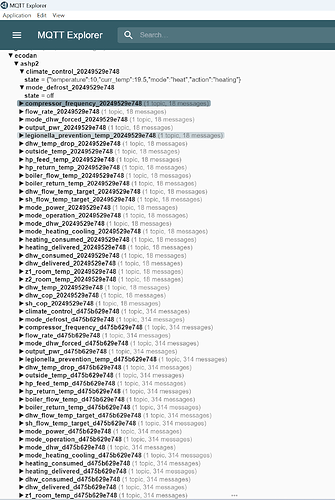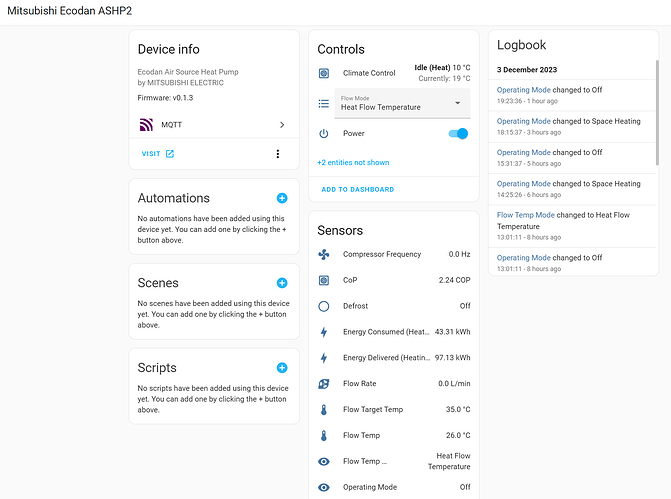@mjr @borpin it is using the MQTT integration to create devices/entities within HA.
It maintains it’s own MQTT namespace where it stores running values and accepts commands.
So you could use MQTT directly if preferred.
You can see a couple of examples below, with the respective MQTT paths for HA to send commands;
Home Assistant Cimate Device:
{
"name": "climate_control_d475b629e748",
"unique_id": "climate_control_d475b629e748",
"icon": "mdi:heat-pump-outline",
"device": {
"ids": [
"d475b629e748"
],
"name": "Mitsubishi A2W Heat Pump",
"sw": "v0.1.4",
"mdl": "Ecodan Air Source Heat Pump",
"mf": "MITSUBISHI ELECTRIC",
"cu": "http://192.168.0.118/configuration"
},
"mode_stat_t": "ecodan/ashp2/climate_control_d475b629e748/state",
"mode_stat_tpl": "{% if (value_json is defined and value_json.mode is defined) %}{{ value_json.mode }}{% else %}off{% endif %}",
"act_t": "ecodan/ashp2/climate_control_d475b629e748/state",
"act_tpl": "{% if (value_json is defined and value_json.mode is defined) %}{{ value_json.action }}{% else %}off{% endif %}",
"temp_stat_t": "ecodan/ashp2/climate_control_d475b629e748/state",
"temp_stat_tpl": "{% if (value_json is defined and value_json.temperature is defined) %}{% if (value_json.temperature|int >= 8.00 and value_json.temperature|int <= 28.00) %}{{ value_json.temperature }}{% elif (value_json.temperature|int < 8.00) %}8.00{% elif (value_json.temperature|int > 28.00) %}28.00{% endif %}{% else %}21{% endif %}",
"curr_temp_t": "ecodan/ashp2/climate_control_d475b629e748/state",
"curr_temp_tpl": "{% if (value_json is defined and value_json.curr_temp is defined) %}{{ value_json.curr_temp }}{% else %}0{% endif %}",
"temp_cmd_t": "ecodan/ashp2/climate_control_d475b629e748/temp_cmd",
"temp_cmd_tpl": "{{ value }}",
"initial": 10,
"min_temp": 8,
"max_temp": 28,
"temp_unit": "C",
"temp_step": 0.5,
"modes": [
"heat",
"off"
]
}
Home Assistant Switch to Force DHW:
{
"name": "force_dhw_d475b629e748",
"unique_id": "force_dhw_d475b629e748",
"icon": "mdi:toggle-switch-variant",
"device": {
"ids": [
"d475b629e748"
],
"name": "Mitsubishi A2W Heat Pump",
"sw": "v0.1.4",
"mdl": "Ecodan Air Source Heat Pump",
"mf": "MITSUBISHI ELECTRIC",
"cu": "http://192.168.0.118/configuration"
},
"stat_t": "ecodan/ashp2/mode_dhw_forced_d475b629e748/state",
"stat_t_tpl": "{{ value }}",
"stat_on": "on",
"stat_off": "off",
"cmd_t": "ecodan/ashp2/force_dhw_d475b629e748/set",
"cmd_tpl": "{{ value }}"
}




